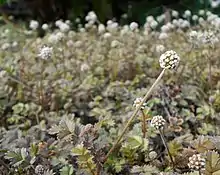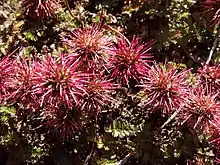| Acaena microphylla | |
|---|---|
 | |
 | |
| Scientific classification | |
| Kingdom: | Plantae |
| Clade: | Tracheophytes |
| Clade: | Angiosperms |
| Clade: | Eudicots |
| Clade: | Rosids |
| Order: | Rosales |
| Family: | Rosaceae |
| Genus: | Acaena |
| Species: | A. microphylla |
| Binomial name | |
| Acaena microphylla | |
Acaena microphylla, the bidibid or piripiri,[4] and outside New Zealand, New Zealand-bur,[5] is a small herbaceous, prostrate perennial flowering plant in the rose family Rosaceae, native to both the North and South Islands of New Zealand.[2] There are two varieties:
There are no synonyms.[2]
Description
Hooker describes it as "a very small and glabrous species; the leaflets not 1/4 in. long. Capitula very large for the size of the plant, upwards of an inch across, including the spines, which are not barbate, and distinguish it as a species."[3]
Taxonomy and naming
Acaena microphylla was first formally described in 1852 by Joseph Dalton Hooker.[2][3] The genus name Acaena is derived from the ancient Greek word akaina, meaning "thorn" or "spine",[7] referring to the spiny calyx of many species of Acaena. The specific epithet microphylla derives from the Greek words, mikros (small) and phyllon (leaf), to give an adjective meaning "small-leaved".[8]
Distribution
It is found on both the North Island and South Island of New Zealand.[2]
Conservation status
In 2013, the variety Acaena microphylla var. pauciglochidiata was classified as "At Risk - Naturally Uncommon" under the New Zealand Threat Classification System. By 2018, due to an actual decline, the status changed to "At Risk - Declining". (The area of occupancy had decreased to 100 km2 or less, and the predicted decline was 10 to 50%).[1] However, the variety Acaena microphylla var. microphylla was classified as "Not Threatened" in 2004, 2009 and 2012,[4] and again in 2018.[1]
References
- 1 2 3 Lange, Peter J. de; Rolfe, Jeremy R.; Barkla, John W.; Courtney, Shannel P.; Champion, Paul D.; Perrie, Leon R.; Beadel, Sarah M.; Ford, Kerry A.; Breitwieser, Ilse; Schönberger, Ines; Hindmarsh-Walls, Rowan (1 May 2018). "Conservation status of New Zealand indigenous vascular plants, 2017" (PDF). New Zealand Threat Classification Series. 22: 9, 53. OCLC 1041649797.
- 1 2 3 4 5 "Acaena microphylla Hook.f. | Plants of the World Online | Kew Science". Plants of the World Online. Retrieved 7 January 2020.
- 1 2 3 Hooker, J.D. (1853). The botany of the Antarctic voyage of H.M. discovery ships Erebus and Terror in the Years 1839-1843 :under the command of Captain Sir James Clark Ross. Vol. 1. p. 55.
 This article incorporates text from this source, which is in the public domain.
This article incorporates text from this source, which is in the public domain. - 1 2 3 "Acaena microphylla var microphylla". New Zealand Plant Conservation Network. Retrieved 8 January 2020.
- ↑ "Acaena microphylla Hook.f." www.gbif.org. Retrieved 7 January 2020.
- ↑ "Acaena microphylla var. pauciglochidiata". New Zealand Plant Conservation Network. Retrieved 8 January 2020.
- ↑ Brown, Roland Wilbur (1956). The Composition of Scientific Words. Washington, D.C.: Smithsonian Institution Press. p. 796.
- ↑ "microphyllus,-a,-um". www.plantillustrations.org. Retrieved 7 January 2020.
External links
- Acaena microphylla occurrence data from Australasian Virtual Herbarium
 Media related to Acaena microphylla at Wikimedia Commons
Media related to Acaena microphylla at Wikimedia Commons
